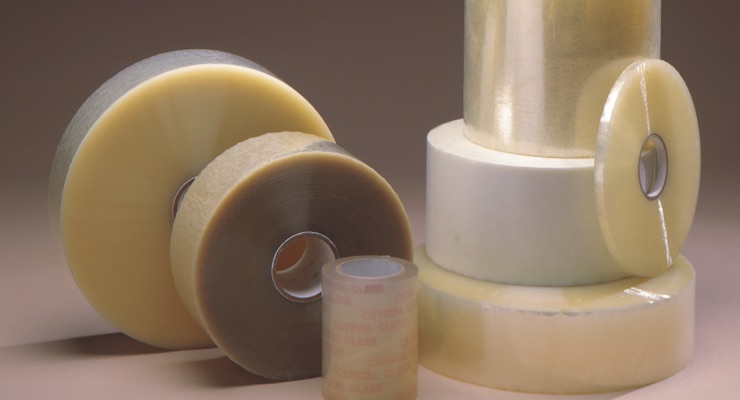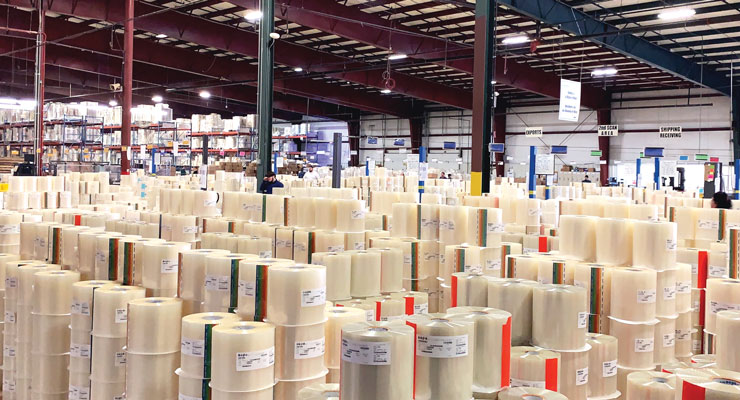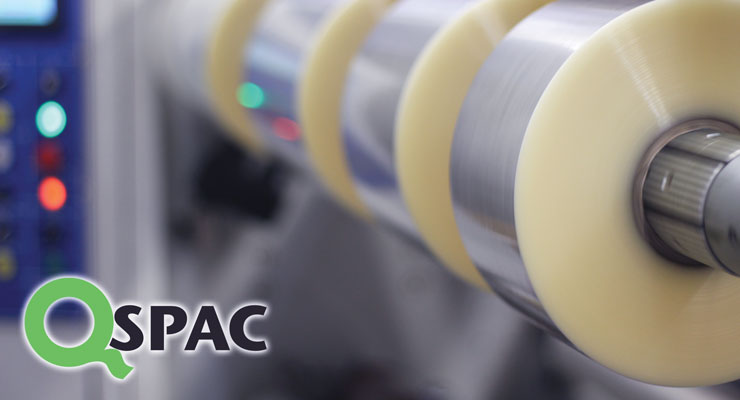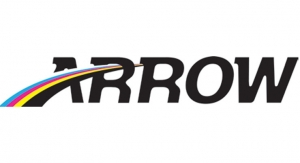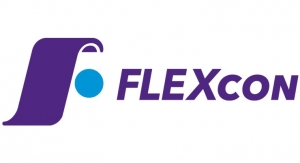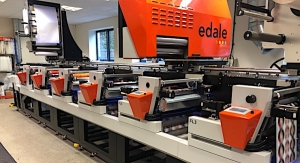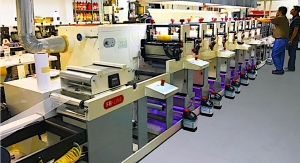Steve Katz, Associate Editor11.12.20
It’s been said that the overlamination film is an underappreciated component of a pressure sensitive label construction. It stands to reason, after all, as the person handling a product or viewing a label might not even know it’s there. Unless, of course, the overlamination film fails – which becomes apparent when the inks or substrates that the film is protecting become smudged or blemished.
Overlamination films can serve aesthetic purposes, in addition to their main role as a label protection measure. For example, these films can add a gloss or matte appearance while serving the primary role of providing protection and durability.
Overlaminate materials come in a roll format, and are applied after the printing is complete and the ink is dried on press. A nip roller applies pressure where the overlaminate and substrate meet, prior to the diecutting station.
These materials do affect the diecutting process, as they add another layer of thickness to the label. Thus, converters should be prepared with dies equipped with the appropriate level of sharpness.
What follows are insights from three of the narrow-web label industry’s key overlaminate suppliers as they discuss the role these products have in label manufacturing, as well as sharing information on their latest products and services.
ACHEM Industry America
Bob Kuminski, National Accounts Sales Manager for Achem, notes that while “2020 has been an extremely difficult year for many due to the COVID-19 pandemic, Achem however has experienced growth, particularly with labels." Furthermore, Kuminski says, hand sanitizer, household goods and pharmaceutical labels have had a noticeable increase.
Polypropylene and polyester are the prominent laminations used to protect these labels from scuffing while offering UV protection when needed. Achem's selfwound, unsupported laminations and Heat Seal Films have also found a home in nutraceutical, pharmaceutical, food and confection industry, as well as a lamination used in stand-up pouches.
According to Kuminski, "In 2021, we will see additional, exciting new products being offered to set new industry standards. These products will be available through our strategically located West Coast, Midwest and East Coast facilities."
Achem is also emphaszing the impact digital printing is having on the industry. "Customer requirements have changed dramatically over the last 5-10 years with expectations passed on to suppliers. With more digital printers, self-wound printable products will grow as variable print designs become more of the norm. Overlamination films will become more of the design of the label instead of simply a protective film. Adhesives, Ink systems and environmental concerns will all contribute to the next generation of overlamination. Market demands are currently driving all of these initiatives," Kuminski says. "Working with adhesive and ink companies to ensure success will be key to evolving lamination films moving forward."
acpo, ltd.
The overlaminate films supplied by acpo are used in a wide range of markets, everywhere from health and beauty to industrial, pharmaceutical, pet food and even aeronautics. “The ease of use and consistency of self-wound overlaminates over UV varnishes or press-applied films greatly benefits the label converter by helping to ensure the first label looks like the last,” explains Cindy Dunfee, customer service and marketing manager for acpo. “It also frees up a print station and reduces non-productive time spent dialing in the varnish or adhesive along with clean up.”
According to Dunfee, an area of exceptional growth acpo continues to see is in the flexible packaging market. “Several years ago, we introduced our first flexible packaging overlaminate, a 48-gauge PET strictly for use as surface print protection. We’ve since expanded the product line to include printable high oxygen barrier films along with heat sealable films. This allows our customers, who of course are traditionally label printers, to venture into the flexible packaging arena with little to no changes on their end.”
Polypropylene (BOPP) overlaminates are acpo’s most popular product for indoor label applications, including extended content, food and beverage, and household goods. “These films provide scuff resistance and additional overall stability to the label at an attractive price point,” Dunfee says.
For more demanding or outdoor applications, Dunfee recommends polyester (PET) overlaminates. She says, “PET films provide higher fade and heat resistance, and overall durability, than BOPPs, making them ideal for industrial equipment labels and applications requiring UL compliance.”
In terms of new products, Dunfee explains, “As acpo is a leading manufacturer and supplier of overlaminates, we are proud of our dedication to new product development. We continue to recognize the desire for innovative products in the label and flexible packaging markets and are uniquely positioned to meet that need. In addition to our flexible packaging line, some of our other recent product launches include Sofsens, a soft to the touch overlam, and GlitterLam, which gives the finished label a gold sparkle that doesn’t rub or flake off,” Dunfee says.
acpo remains committed to providing the best possible service to its customers. Dunfee says, “We now have two manufacturing facilities along with four slitting and warehousing locations across the US. Additionally, our growing strategic international distribution partnerships allow acpo products to be made available across the globe. We also offer our customers technical support to train and educate – whether it’s by phone, email, video conference or in person.
“We are proud to be the pioneer and industry leader of self-wound overlaminates but still have the flexibility to grow, ” Dunfee concludes, adding, “acpo has made the investments and is prepared for that growth. We live and breathe our tagline: Films with Technology. Products with Purpose.”
FLEXcon Company, inc.
According to Ross Hodnett, product manager for FLEXcon, as the label market grows, so too does the demand for overlaminates. He says, “Developments in certain newer, more durable print technologies – like UV inkjet – may eliminate the need for an overlaminate in some cases, but generally speaking, there are still many reasons to use an overlaminate. Overall, it is not being replaced by other technology developments.”
Hodnett points out that for FLEXcon, by far the most popular overlamination materials for labeling applications are clear polyesters. He says, “FLEXcon DPM polyesters come in several formats. Our clear gloss and clear matte polyesters are outdoor-durable for two years, while our UV-blocking polyesters provide up to five years of outdoor durable protection. These materials yield excellent clarity and label protection, are highly durable, and protect graphics from extended UV light exposure.”
FLEXcon’s newest overlaminate offering is designed specifically for UV inkjet printing. The heavy ink deposition of this technology requires a thicker adhesive coat weight to spread out well over the inks for optimal adhesion. They are available in both regular and UV-blocking options. FLEXcon also offers printable polyester overlaminates for projects where variable information will be printed via thermal transfer on top.
According to Hodnett, there are two reasons to overlaminate. “The first is to protect graphics from abrasion, chemicals, sunlight and other exposures,” he says. “The second is to achieve a specific appearance that the base film and ink cannot provide on their own such as a specialty texture or visual effect. When choosing an overlaminate, then, the questions are: What does it need to do? And how does it need to look?”
Labels on items that will be used outdoors stand to benefit most from overlamination because they are likely to be exposed to temperature extremes and sunlight, Hodnett explains. “These include products in the consumer durables, transportation, industrial, construction and energy markets, which may be exposed to oils and gases, abrasion, and chemicals in addition to weather. Certain indoor-use items, such as medical devices and power tools, are also good candidates for overlamination, as they can be exposed to cleaning solutions and abrasion that could impact label readability if not overlaminated. Finally, while primary labels may not require overlamination for durability reasons, specific tactile and visual effects to improve shelf appeal can be achieved with specialty products such as textured or holographic overlaminates.”
FLEXcon’s durable labeling overlaminates have been thoroughly tested in the company’s in-house DAP-certified lab to meet UL, cUL and CSA requirements when used with specific FLEXcon base films. They are immediately adoptable, and basic adoption fees are reimbursable upon meeting a specific sales threshold. FLEXcon can also work with label converters to obtain UL, cUL or CSA recognition on custom constructions or non-standard base film/overlaminate combinations should the standard offering not meet application requirements.
QSPAC industries, inc.
Howard Shen, director of overlamination products for QSPAC Industries, Inc., points out that while the main role of an overlamination film is to provide protection for a label’s printed content and graphics, there are a host of other benefits, as well. He says, “It protects the label from moisture, chemicals, oils, acid, dirt, abrasion and even UV rays, but they also offer several other advantages. For example, overlamination films are less expensive compared to linered overlaminates. And they provide labels with enhanced strength and durability, which add value to the finished product. Plus, they are easy to use and set up on press – one of the reasons overlaminates have been used and accepted by label converters for over 30 years.”
QSPAC has seen customer demand for matte-finish overlaminates continuing to grow year-after-year, Shen says, with stand-up pouches and flexible packaging applications evolving as areas of growth for using self-wound films to laminate.
According to Shen, the most common challenge converters face when using overlaminates is tension control. “Poor tension control can lead to label curls and wrinkles,” he explains. In response to this, QSPAC offers a silencer attachment that makes converting overlaminates significantly easier. The silencer reduces the noise and maintains the tension during the unwinding of the roll.
QSPAC’s overlamination films are popular materials within many end-use label markets, including food, beverage, household, personal care, health and beauty, promotional, industrial, pharmaceutical, medical, sweepstakes, dairy, automotive and more. “All these markets are a good fit for using overlamination. We see a lot of clear-on-clear labels used with beverages and personal care products. Matte finish overlamination is a popular choice for use on health and beauty products, while extended content labels for the pharmaceutical industry use overlamination. Dairy labels and food products are laminated; car batteries and car care products are laminated. There are simply so many label and pressure sensitive applications that can benefit from the added durability – and enhanced aesthetics – that overlaminates provide,” Shen says.
QSPAC’s two most popular lamination products among its label converter customers are clear and matte finish. “Both are BOPP films and coated with an emulsion acrylic adhesive,” explains Shen. “Both are used to protect the label and give the label either a glossy or matte finish look.”
Shen notes that in light of supply chain challenges many converters and suppliers to the industry have experienced since the start of the coronavirus pandemic, QSPAC has been able to deliver products to its customers without any delays from one of its four strategically located converting/shipping facilities. He adds, “We have kept up with increased market demand seamlessly, as we know our customers rely on us in order to keep up with their customers’ fast turnaround time demands.”
QSPAC is currently working on new self-wound products that will be available in 2021, which will be competitively priced while offering a host of performance and aesthetic benefits.
Overlamination films can serve aesthetic purposes, in addition to their main role as a label protection measure. For example, these films can add a gloss or matte appearance while serving the primary role of providing protection and durability.
Overlaminate materials come in a roll format, and are applied after the printing is complete and the ink is dried on press. A nip roller applies pressure where the overlaminate and substrate meet, prior to the diecutting station.
These materials do affect the diecutting process, as they add another layer of thickness to the label. Thus, converters should be prepared with dies equipped with the appropriate level of sharpness.
What follows are insights from three of the narrow-web label industry’s key overlaminate suppliers as they discuss the role these products have in label manufacturing, as well as sharing information on their latest products and services.
ACHEM Industry America
Bob Kuminski, National Accounts Sales Manager for Achem, notes that while “2020 has been an extremely difficult year for many due to the COVID-19 pandemic, Achem however has experienced growth, particularly with labels." Furthermore, Kuminski says, hand sanitizer, household goods and pharmaceutical labels have had a noticeable increase.
Polypropylene and polyester are the prominent laminations used to protect these labels from scuffing while offering UV protection when needed. Achem's selfwound, unsupported laminations and Heat Seal Films have also found a home in nutraceutical, pharmaceutical, food and confection industry, as well as a lamination used in stand-up pouches.
According to Kuminski, "In 2021, we will see additional, exciting new products being offered to set new industry standards. These products will be available through our strategically located West Coast, Midwest and East Coast facilities."
Achem is also emphaszing the impact digital printing is having on the industry. "Customer requirements have changed dramatically over the last 5-10 years with expectations passed on to suppliers. With more digital printers, self-wound printable products will grow as variable print designs become more of the norm. Overlamination films will become more of the design of the label instead of simply a protective film. Adhesives, Ink systems and environmental concerns will all contribute to the next generation of overlamination. Market demands are currently driving all of these initiatives," Kuminski says. "Working with adhesive and ink companies to ensure success will be key to evolving lamination films moving forward."
acpo, ltd.
The overlaminate films supplied by acpo are used in a wide range of markets, everywhere from health and beauty to industrial, pharmaceutical, pet food and even aeronautics. “The ease of use and consistency of self-wound overlaminates over UV varnishes or press-applied films greatly benefits the label converter by helping to ensure the first label looks like the last,” explains Cindy Dunfee, customer service and marketing manager for acpo. “It also frees up a print station and reduces non-productive time spent dialing in the varnish or adhesive along with clean up.”
According to Dunfee, an area of exceptional growth acpo continues to see is in the flexible packaging market. “Several years ago, we introduced our first flexible packaging overlaminate, a 48-gauge PET strictly for use as surface print protection. We’ve since expanded the product line to include printable high oxygen barrier films along with heat sealable films. This allows our customers, who of course are traditionally label printers, to venture into the flexible packaging arena with little to no changes on their end.”
Polypropylene (BOPP) overlaminates are acpo’s most popular product for indoor label applications, including extended content, food and beverage, and household goods. “These films provide scuff resistance and additional overall stability to the label at an attractive price point,” Dunfee says.
For more demanding or outdoor applications, Dunfee recommends polyester (PET) overlaminates. She says, “PET films provide higher fade and heat resistance, and overall durability, than BOPPs, making them ideal for industrial equipment labels and applications requiring UL compliance.”
In terms of new products, Dunfee explains, “As acpo is a leading manufacturer and supplier of overlaminates, we are proud of our dedication to new product development. We continue to recognize the desire for innovative products in the label and flexible packaging markets and are uniquely positioned to meet that need. In addition to our flexible packaging line, some of our other recent product launches include Sofsens, a soft to the touch overlam, and GlitterLam, which gives the finished label a gold sparkle that doesn’t rub or flake off,” Dunfee says.
acpo remains committed to providing the best possible service to its customers. Dunfee says, “We now have two manufacturing facilities along with four slitting and warehousing locations across the US. Additionally, our growing strategic international distribution partnerships allow acpo products to be made available across the globe. We also offer our customers technical support to train and educate – whether it’s by phone, email, video conference or in person.
“We are proud to be the pioneer and industry leader of self-wound overlaminates but still have the flexibility to grow, ” Dunfee concludes, adding, “acpo has made the investments and is prepared for that growth. We live and breathe our tagline: Films with Technology. Products with Purpose.”
FLEXcon Company, inc.
According to Ross Hodnett, product manager for FLEXcon, as the label market grows, so too does the demand for overlaminates. He says, “Developments in certain newer, more durable print technologies – like UV inkjet – may eliminate the need for an overlaminate in some cases, but generally speaking, there are still many reasons to use an overlaminate. Overall, it is not being replaced by other technology developments.”
Hodnett points out that for FLEXcon, by far the most popular overlamination materials for labeling applications are clear polyesters. He says, “FLEXcon DPM polyesters come in several formats. Our clear gloss and clear matte polyesters are outdoor-durable for two years, while our UV-blocking polyesters provide up to five years of outdoor durable protection. These materials yield excellent clarity and label protection, are highly durable, and protect graphics from extended UV light exposure.”
FLEXcon’s newest overlaminate offering is designed specifically for UV inkjet printing. The heavy ink deposition of this technology requires a thicker adhesive coat weight to spread out well over the inks for optimal adhesion. They are available in both regular and UV-blocking options. FLEXcon also offers printable polyester overlaminates for projects where variable information will be printed via thermal transfer on top.
According to Hodnett, there are two reasons to overlaminate. “The first is to protect graphics from abrasion, chemicals, sunlight and other exposures,” he says. “The second is to achieve a specific appearance that the base film and ink cannot provide on their own such as a specialty texture or visual effect. When choosing an overlaminate, then, the questions are: What does it need to do? And how does it need to look?”
Labels on items that will be used outdoors stand to benefit most from overlamination because they are likely to be exposed to temperature extremes and sunlight, Hodnett explains. “These include products in the consumer durables, transportation, industrial, construction and energy markets, which may be exposed to oils and gases, abrasion, and chemicals in addition to weather. Certain indoor-use items, such as medical devices and power tools, are also good candidates for overlamination, as they can be exposed to cleaning solutions and abrasion that could impact label readability if not overlaminated. Finally, while primary labels may not require overlamination for durability reasons, specific tactile and visual effects to improve shelf appeal can be achieved with specialty products such as textured or holographic overlaminates.”
FLEXcon’s durable labeling overlaminates have been thoroughly tested in the company’s in-house DAP-certified lab to meet UL, cUL and CSA requirements when used with specific FLEXcon base films. They are immediately adoptable, and basic adoption fees are reimbursable upon meeting a specific sales threshold. FLEXcon can also work with label converters to obtain UL, cUL or CSA recognition on custom constructions or non-standard base film/overlaminate combinations should the standard offering not meet application requirements.
QSPAC industries, inc.
Howard Shen, director of overlamination products for QSPAC Industries, Inc., points out that while the main role of an overlamination film is to provide protection for a label’s printed content and graphics, there are a host of other benefits, as well. He says, “It protects the label from moisture, chemicals, oils, acid, dirt, abrasion and even UV rays, but they also offer several other advantages. For example, overlamination films are less expensive compared to linered overlaminates. And they provide labels with enhanced strength and durability, which add value to the finished product. Plus, they are easy to use and set up on press – one of the reasons overlaminates have been used and accepted by label converters for over 30 years.”
QSPAC has seen customer demand for matte-finish overlaminates continuing to grow year-after-year, Shen says, with stand-up pouches and flexible packaging applications evolving as areas of growth for using self-wound films to laminate.
According to Shen, the most common challenge converters face when using overlaminates is tension control. “Poor tension control can lead to label curls and wrinkles,” he explains. In response to this, QSPAC offers a silencer attachment that makes converting overlaminates significantly easier. The silencer reduces the noise and maintains the tension during the unwinding of the roll.
QSPAC’s overlamination films are popular materials within many end-use label markets, including food, beverage, household, personal care, health and beauty, promotional, industrial, pharmaceutical, medical, sweepstakes, dairy, automotive and more. “All these markets are a good fit for using overlamination. We see a lot of clear-on-clear labels used with beverages and personal care products. Matte finish overlamination is a popular choice for use on health and beauty products, while extended content labels for the pharmaceutical industry use overlamination. Dairy labels and food products are laminated; car batteries and car care products are laminated. There are simply so many label and pressure sensitive applications that can benefit from the added durability – and enhanced aesthetics – that overlaminates provide,” Shen says.
QSPAC’s two most popular lamination products among its label converter customers are clear and matte finish. “Both are BOPP films and coated with an emulsion acrylic adhesive,” explains Shen. “Both are used to protect the label and give the label either a glossy or matte finish look.”
Shen notes that in light of supply chain challenges many converters and suppliers to the industry have experienced since the start of the coronavirus pandemic, QSPAC has been able to deliver products to its customers without any delays from one of its four strategically located converting/shipping facilities. He adds, “We have kept up with increased market demand seamlessly, as we know our customers rely on us in order to keep up with their customers’ fast turnaround time demands.”
QSPAC is currently working on new self-wound products that will be available in 2021, which will be competitively priced while offering a host of performance and aesthetic benefits.

